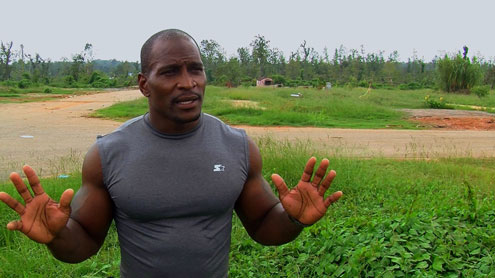The heroes that emerged from the April 27 tornado in Tuscaloosa included more than just firefighters and police. They were real people with real stories.
In his recent documentary, April’s Hero, Dwight Cammeron, a telecommunication and film professor at the University, focused on a hero with a unique story of his own.
“I wanted to find someone who had contributed to the overall rescuing people who actually was not law enforcement,” he said. “That’s how I came across Robert…the ultimate first responder.”
The documentary details the life of Robert Reed before and after the tornado. It draws upon interviews with several people who knew Reed at the time and connects their stories in a format similar to “Crash,” Cammeron said.
Cammeron said people need to remember that a character has a life before any defining moment or big life-changer.
Reed, the documentary’s focus, struggled to find neighbors’ acceptance after moving into the trailer park with a prison record. His family was also discriminated against based on their race, among other factors, as seen in the documentary.
The neighborhood’s view of Reed changed after he performed feats likening him to Superman or an angel, as some neighbors said in the documentary. Reed lifted incredible amounts of weight to save the lives of many as his wife, April, lay injured several yards away.
The documentary’s title, “April’s Hero,” is named after her. The two were high school sweethearts and have faced numerous challenges, many of which are detailed in the documentary.
Cammeron said despite Reed’s heroism, his struggles have not stopped, and he still faces daily challenges.
“Even though the debris has been cleared, there are people that are still trying to put their lives back together,” Cammeron said.
The documentary demanded many long hours. Most people fail to understand how much work really goes into the process, he said.
However, he did have the help of a few students. Jazzmine Franklin, a senior majoring in telecommunication and film, said she worked with Cammeron, doing whatever he asked. She particularly focused on environmental audio.
Cammeron also enlisted Shelby Hadden, a junior majoring in telecommunication and film who was a natural at documentaries, Cammeron said.
“Ever since I met him and transferred, I always wanted to work with him,” Hadden said. “I’ve learned a lot by doing this.”
Hadden transferred to UA from Syracuse University in 2010. Cammeron was one of the first professors she met, who led her through a complete tour of Reese Phifer, Hadden said.
“He really sold me on coming here,” she said.
She said she worked with Cammeron from the project’s initiation in August. She was involved in all parts of the project as videographer, interviewer and primary editor.
Though Hadden was in Tuscaloosa at the time of the tornado, she said she was pretty much unaffected. Working with Cammeron changed this. Suddenly, the event became more real to her.
The documentary runs 25 minutes. It is not yet completed, but Hadden and Cammeron both said it is close to completion. They plan to show the documentary in various film festivals in the near future.









